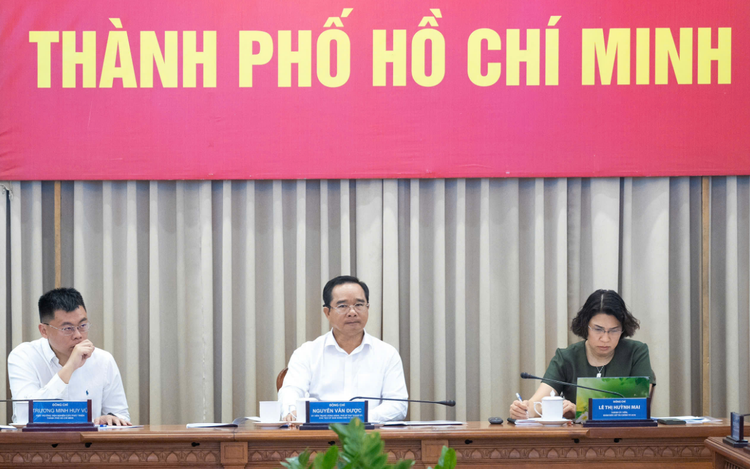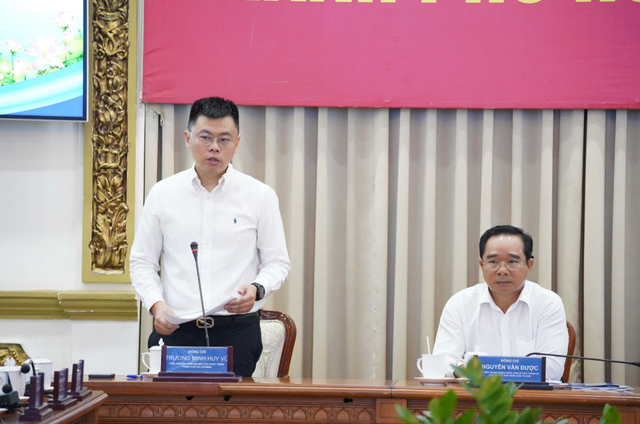
Chairman of the Ho Chi Minh City People’s Committee Nguyen Van Duoc (middle) chairs a seminar on the city's economic growth amidst the impact of the new U.S. tariff policy on April 9, 2025. Photo: Huu Hanh / Tuoi Tre
The event on the city's economic growth amidst the impact of the new U.S. reciprocal tariff policy was co-chaired by chairman Duoc, Le Thi Huynh Mai, director of the municipal Department of Finance, and Truong Minh Huy Vu, head of the Ho Chi Minh City Institute for Development Studies.
Chairman Duoc emphasized that the newly-announced tariff policy had sent shockwaves through several countries, including Vietnam, with Ho Chi Minh City also feeling the negative effects.
Vietnam is among the countries facing steep retaliatory tariffs from the United States, with a 46-percent rate, among the highest announced by President Donald Trump during a White House Rose Garden ceremony on Wednesday last week (U.S. time).
The country-specific retaliatory tariffs takes effect today, April 9.
The imposition of the steep tariffs is expected to increase the cost of exporting Vietnamese goods to the U.S., reducing their competitiveness.
This impact is particularly significant as Vietnam is ramping up its imports of hi-tech, high-value products from the U.S..
He acknowledged that the new tariff policy would have a considerable impact on the city's growth target of 8.5 percent for 2025, as set by the national government.
The leadership of the Party and the state has been proactive and flexible in response to the steep tariff, Duoc said.
Immediately after the U.S. announced its tariff on Vietnam, Party chief To Lam held phone talks with U.S. President Trump to discuss the Vietnam-U.S. relations and emphasize Vietnam's willingness to negotiate a zero-percent import tariff on goods from the U.S..
However, negotiations will still be difficult, he said.
He expressed his desire to hear from experts, economists, and representatives from industry associations to better understand the scope of the impact and how it might affect the city's economic performance and growth rate.
"The insights from experts and industry associations will provide Ho Chi Minh City with a comprehensive view, enabling us to develop strategies for overcoming these challenges," Duoc underlined.

Dr. Truong Minh Huy Vu, head of the Ho Chi Minh City Institute for Development Studies, speaks at the seminar on April 9, 2025. Photo: Huu Hanh / Tuoi Tre
3 growth scenarios for Ho Chi Minh City
The municipal administration had previously set a gross regional domestic product (GRDP) growth target of 10 percent for 2025.
Dr. Vu from the Ho Chi Minh City Institute for Development Studies outlined three possible scenarios for the tariffs the U.S. could impose on Vietnam after negotiations.
* Scenario 1: The tariff rate remains unchanged at 46 percent, which is the most pessimistic scenario. Under this scenario, the city's GRDP growth rate in 2025 would be 5.19 percent.
* Scenario 2: After the negotiations, the U.S. imposes a tariff of 25 percent. In this case, the GRDP growth rate in 2025 would reach 6.79 percent.
* Scenario 3: Vietnam successfully negotiates a reduction of the tariff to 5-15 percent, which would lead to a GRDP growth rate of 7.93 percent.
These scenarios were developed under the assumption that Ho Chi Minh City would take proactive steps to accelerate internal economic growth through investments and consumer spending.
Specifically, the total social investment capital would be VND620 trillion (US$23.8 billion), and retail sales and consumer service revenue would increase 13.4 percent.
Besides, the institute put forward seven key solutions for experts to discuss at the seminar.
One of the key proposals focused on import-export activities. The institute suggested that Vietnam should negotiate a 'bilateral solution package' to ease the tension and lower the average tariff rate after negotiations.
Other proposals included tightening control over origin fraud, with a focus on ensuring transparency in the value chain, particularly concerning goods that are transshipped from third countries to Vietnam before being exported to the U.S..
Furthermore, the institute hinted at beefing up imports of hi-tech products and facilitating investments from U.S. enterprises in Vietnam, contributing to reducing the trade deficit between the two nations.
The institute also suggested diversifying markets and strengthening international cooperation, particularly leveraging Vietnam's existing free trade agreements.
The city should increase exports to the European Union, especially to countries like Germany, Spain, and Poland, where trade exchanges with Vietnam have been steadily growing.
Additionally, efforts should be made to develop supply chains within ASEAN, the Regional Comprehensive Economic Partnership, and the Comprehensive and Progressive Agreement for Trans-Pacific Partnership.
The city could also expand cooperation with Mexico and Canada to take advantage of the U.S.-Mexico-Canada agreement for indirect exports to the U.S. and leverage free trade agreements with Middle Eastern countries to further expand trade in these markets.


Max: 1500 characters
There are no comments yet. Be the first to comment.